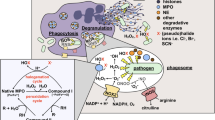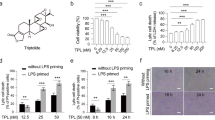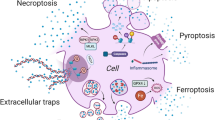Abstract
Mycobacterium avium and its sonic extracts induce apoptosis in macrophages. However, little is known about the M. avium components regulating macrophage apoptosis. In this study, using multidimensional fractionation, we identified MAV2052 protein, which induced macrophage apoptosis in M. avium culture filtrates. The recombinant MAV2052 induced macrophage apoptosis in a caspase-dependent manner. The loss of mitochondrial transmembrane potential (ΔΨm), mitochondrial translocation of Bax, and release of cytochrome c from mitochondria were observed in macrophages treated with MAV2052. Further, reactive oxygen species (ROS) production was required for the apoptosis induced by MAV2052. In addition, ROS and mitogen-activated protein kinases were involved in MAV2052-mediated TNF-α and IL-6 production. ROS-mediated activation of apoptosis signal-regulating kinase 1 (ASK1)-JNK pathway was a major signaling pathway for MAV2052-induced apoptosis. Moreover, MAV2052 bound to Toll-like receptor (TLR) 4 molecule and MAV2052-induced ROS production, ΔΨm loss, and apoptosis were all significantly reduced in TLR4−/− macrophages. Altogether, our results suggest that MAV2052 induces apoptotic cell death through TLR4 dependent ROS production and JNK pathway in murine macrophages.







Similar content being viewed by others
References
Johnson MM, Odell JA (2014) Nontuberculous mycobacterial pulmonary infections. J Thorac Dis 6(3):210–220. doi:10.3978/j.issn.2072-1439.2013.12.24
Koh WJ, Kim YH, Kwon OJ, Choi YS, Kim K, Shim YM, Kim J (2008) Surgical treatment of pulmonary diseases due to nontuberculous mycobacteria. J Korean Med Sci 23(3):397–401. doi:10.3346/jkms.2008.23.3.397
Vergne I, Chua J, Singh SB, Deretic V (2004) Cell biology of mycobacterium tuberculosis phagosome. Annu Rev Cell Dev Bi 20:367–394. doi:10.1146/annurev.cellbio.20.010403.114015
Briken V, Miller JL (2008) Living on the edge: inhibition of host cell apoptosis by Mycobacterium tuberculosis. Future Microbiol 3(4):415–422. doi:10.2217/17460913.3.4.415
Velmurugan K, Chen B, Miller JL, Azogue S, Gurses S, Hsu T, Glickman M, Jacobs WR Jr, Porcelli SA, Briken V (2007) Mycobacterium tuberculosis nuoG is a virulence gene that inhibits apoptosis of infected host cells. PLoS Pathog 3(7):e110. doi:10.1371/journal.ppat.0030110
Kurtz S, McKinnon KP, Runge MS, Ting JP, Braunstein M (2006) The SecA2 secretion factor of Mycobacterium tuberculosis promotes growth in macrophages and inhibits the host immune response. Infect Immunol 74(12):6855–6864. doi:10.1128/IAI.01022-06
Jayakumar D, Jacobs WR Jr, Narayanan S (2008) Protein kinase E of Mycobacterium tuberculosis has a role in the nitric oxide stress response and apoptosis in a human macrophage model of infection. Cell Microbiol 10(2):365–374. doi:10.1111/j.1462-5822.2007.01049.x
Lopez M, Sly LM, Luu Y, Young D, Cooper H, Reiner NE (2003) The 19-kDa Mycobacterium tuberculosis protein induces macrophage apoptosis through Toll-like receptor-2. J Immunol 170(5):2409–2416
Basu S, Pathak SK, Banerjee A, Pathak S, Bhattacharyya A, Yang Z, Talarico S, Kundu M, Basu J (2007) Execution of macrophage apoptosis by PE_PGRS33 of Mycobacterium tuberculosis is mediated by Toll-like receptor 2-dependent release of tumor necrosis factor-alpha. J Biol Chem 282(2):1039–1050. doi:10.1074/jbc.M604379200
Maiti D, Bhattacharyya A, Basu J (2001) Lipoarabinomannan from Mycobacterium tuberculosis promotes macrophage survival by phosphorylating Bad through a phosphatidylinositol 3-kinase/Akt pathway. J Biol Chem 276(1):329–333. doi:10.1074/jbc.M002650200
Guerardel Y, Maes E, Briken V, Chirat F, Leroy Y, Locht C, Strecker G, Kremer L (2003) Lipomannan and lipoarabinomannan from a clinical isolate of Mycobacterium kansasii: novel structural features and apoptosis-inducing properties. J Biol Chem 278(38):36637–36651. doi:10.1074/jbc.M305427200
Gan H, Newman GW, Remold HG (1995) Plasminogen activator inhibitor type 2 prevents programmed cell death of human macrophages infected with Mycobacterium avium, serovar 4. J Immunol 155(3):1304–1315
Bermudez LE, Parker A, Petrofsky M (1999) Apoptosis of Mycobacterium avium-infected macrophages is mediated by both tumour necrosis factor (TNF) and Fas, and involves the activation of caspases. Clin Exp Immunol 116(1):94–99
Bhattacharyya A, Pathak S, Basak C, Law S, Kundu M, Basu J (2003) Execution of macrophage apoptosis by Mycobacterium avium through apoptosis signal-regulating kinase 1/p38 mitogen-activated protein kinase signaling and caspase 8 activation. J Biol Chem 278(29):26517–26525. doi:10.1074/jbc.M300852200
Hayashi T, Catanzaro A, Rao SP (1997) Apoptosis of human monocytes and macrophages by Mycobacterium avium sonicate. Infect Immunol 65(12):5262–5271
Shin AR, Lee KS, Lee KI, Shim TS, Koh WJ, Jeon HS, Son YJ, Shin SJ, Kim HJ (2013) Serodiagnostic potential of Mycobacterium avium MAV2054 and MAV5183 proteins. Clin Vaccine Immunol: CVI 20(2):295–301. doi:10.1128/CVI.00649-12
Jeon HS, Shin AR, Son YJ, Kim JM, Jang Y, Kim S, Lee KI, Choi CH, Park JK, Kim HJ (2015) An evaluation of the use of immunoglobulin A antibody response against mycobacterial antigens for the diagnosis of Mycobacterium bovis infection in cattle. J Vet Diagn Invest 27(3):344–351. doi:10.1177/1040638715578879
Shin AR, Shin SJ, Lee KS, Eom SH, Lee SS, Lee BS, Lee JS, Cho SN, Kim HJ (2008) Improved sensitivity of diagnosis of tuberculosis in patients in Korea via a cocktail enzyme-linked immunosorbent assay containing the abundantly expressed antigens of the K strain of Mycobacterium tuberculosis. Clin Vaccine Immunol: CVI 15(12):1788–1795. doi:10.1128/CVI.00231-08
Lim JH, Park JK, Jo EK, Song CH, Min D, Song YJ, Kim HJ (1999) Purification and immunoreactivity of three components from the 30/32-kilodalton antigen 85 complex in Mycobacterium tuberculosis. Infect Immunol 67(11):6187–6190
Giri PK, Verma I, Khuller GK (2006) Enhanced immunoprotective potential of Mycobacterium tuberculosis Ag85 complex protein based vaccine against airway Mycobacterium tuberculosis challenge following intranasal administration. FEMS Immunol Med Microbiol 47(2):233–241. doi:10.1111/j.1574-695X.2006.00087.x
Sohn H, Kim JS, Shin SJ, Kim K, Won CJ, Kim WS, Min KN, Choi HG, Lee JC, Park JK, Kim HJ (2011) Targeting of Mycobacterium tuberculosis heparin-binding hemagglutinin to mitochondria in macrophages. PLoS Pathog 7(12):e1002435. doi:10.1371/journal.ppat.1002435
Azad N, Iyer AK, Manosroi A, Wang L, Rojanasakul Y (2008) Superoxide-mediated proteasomal degradation of Bcl-2 determines cell susceptibility to Cr(VI)-induced apoptosis. Carcinogenesis 29(8):1538–1545. doi:10.1093/carcin/bgn137
Perskvist N, Long M, Stendahl O, Zheng L (2002) Mycobacterium tuberculosis promotes apoptosis in human neutrophils by activating caspase-3 and altering expression of Bax/Bcl-xL via an oxygen-dependent pathway. J Immunol 168(12):6358–6365
Yang CS, Lee HM, Lee JY, Kim JA, Lee SJ, Shin DM, Lee YH, Lee DS, El-Benna J, Jo EK (2007) Reactive oxygen species and p47phox activation are essential for the Mycobacterium tuberculosis-induced pro-inflammatory response in murine microglia. J Neuroinflamm 4:27. doi:10.1186/1742-2094-4-27
Seo SK, Lee HC, Woo SH, Jin HO, Yoo DH, Lee SJ, An S, Choe TB, Park MJ, Hong SI, Park IC, Rhee CH (2007) Sulindac-derived reactive oxygen species induce apoptosis of human multiple myeloma cells via p38 mitogen activated protein kinase-induced mitochondrial dysfunction. Apoptosis Int J Program Cell Death 12(1):195–209. doi:10.1007/s10495-006-0527-5
Choi HG, Kim WS, Back YW, Kim H, Kwon KW, Kim JS, Shin SJ, Kim HJ (2015) Mycobacterium tuberculosis RpfE promotes simultaneous Th1- and Th17-type T-cell immunity via TLR4-dependent maturation of dendritic cells. Eur J Immunol 45(7):1957–1971. doi:10.1002/eji.201445329
Byun EH, Kim WS, Kim JS, Jung ID, Park YM, Kim HJ, Cho SN, Shin SJ (2012) Mycobacterium tuberculosis Rv0577, a novel TLR2 agonist, induces maturation of dendritic cells and drives Th1 immune response. FASEB J 26(6):2695–2711. doi:10.1096/fj.11-199588
Rodrigues MF, Barsante MM, Alves CC, Souza MA, Ferreira AP, Amarante-Mendes GP, Teixeira HC (2009) Apoptosis of macrophages during pulmonary Mycobacterium bovis infection: correlation with intracellular bacillary load and cytokine levels. Immunology 128(1 Suppl):e691–699. doi:10.1111/j.1365-2567.2009.03062.x
Barry DP, Beaman BL (2006) Modulation of eukaryotic cell apoptosis by members of the bacterial order Actinomycetales. Apoptosis Int J Program Cell Death 11(10):1695–1707. doi:10.1007/s10495-006-9236-3
Malen H, Berven FS, Fladmark KE, Wiker HG (2007) Comprehensive analysis of exported proteins from Mycobacterium tuberculosis H37Rv. Proteomics 7(10):1702–1718. doi:10.1002/pmic.200600853
Green DR, Reed JC (1998) Mitochondria and apoptosis. Science 281(5381):1309–1312
Hiura TS, Li N, Kaplan R, Horwitz M, Seagrave JC, Nel AE (2000) The role of a mitochondrial pathway in the induction of apoptosis by chemicals extracted from diesel exhaust particles. J Immunol 165(5):2703–2711
Gupta S, Yel L, Kim D, Kim C, Chiplunkar S, Gollapudi S (2003) Arsenic trioxide induces apoptosis in peripheral blood T lymphocyte subsets by inducing oxidative stress: a role of Bcl-2. Mol Cancer Ther 2(8):711–719
Bermudez LE, Young LS, Gupta S (1990) 1,25 Dihydroxyvitamin D3-dependent inhibition of growth or killing of Mycobacterium avium complex in human macrophages is mediated by TNF and GM-CSF. Cell Immunol 127(2):432–441
Choi JA, Lim YJ, Cho SN, Lee JH, Jeong JA, Kim EJ, Park JB, Kim SH, Park HS, Kim HJ, Song CH (2013) Mycobacterial HBHA induces endoplasmic reticulum stress-mediated apoptosis through the generation of reactive oxygen species and cytosolic Ca2+ in murine macrophage RAW 264.7 cells. Cell Death Dis 4:e957. doi:10.1038/cddis.2013.489
Bulua AC, Simon A, Maddipati R, Pelletier M, Park H, Kim KY, Sack MN, Kastner DL, Siegel RM (2011) Mitochondrial reactive oxygen species promote production of proinflammatory cytokines and are elevated in TNFR1-associated periodic syndrome (TRAPS). J Exp Med 208(3):519–533. doi:10.1084/jem.20102049
Byun JY, Kim MJ, Eum DY, Yoon CH, Seo WD, Park KH, Hyun JW, Lee YS, Lee JS, Yoon MY, Lee SJ (2009) Reactive oxygen species-dependent activation of Bax and poly(ADP-ribose) polymerase-1 is required for mitochondrial cell death induced by triterpenoid pristimerin in human cervical cancer cells. Mol Pharmacol 76(4):734–744. doi:10.1124/mol.109.056259
Noguchi T, Ishii K, Fukutomi H, Naguro I, Matsuzawa A, Takeda K, Ichijo H (2008) Requirement of reactive oxygen species-dependent activation of ASK1-p38 MAPK pathway for extracellular ATP-induced apoptosis in macrophage. J Biol Chem 283(12):7657–7665. doi:10.1074/jbc.M708402200
Shieh JM, Huang TF, Hung CF, Chou KH, Tsai YJ, Wu WB (2010) Activation of c-Jun N-terminal kinase is essential for mitochondrial membrane potential change and apoptosis induced by doxycycline in melanoma cells. Brit J Pharmacol 160(5):1171–1184. doi:10.1111/j.1476-5381.2010.00746.x
Tobiume K, Matsuzawa A, Takahashi T, Nishitoh H, Morita K, Takeda K, Minowa O, Miyazono K, Noda T, Ichijo H (2001) ASK1 is required for sustained activations of JNK/p38 MAP kinases and apoptosis. EMBO Rep 2(3):222–228. doi:10.1093/embo-reports/kve046
Hsu MJ, Chang CK, Chen MC, Chen BC, Ma HP, Hong CY, Lin CH (2010) Apoptosis signal-regulating kinase 1 in peptidoglycan-induced COX-2 expression in macrophages. J Leukocyte Biol 87(6):1069–1082. doi:10.1189/jlb.1009668
Gehring AJ, Rojas RE, Canaday DH, Lakey DL, Harding CV, Boom WH (2003) The Mycobacterium tuberculosis 19-kilodalton lipoprotein inhibits gamma interferon-regulated HLA-DR and Fc gamma R1 on human macrophages through Toll-like receptor 2. Infect Immunol 71(8):4487–4497
Nair S, Ramaswamy PA, Ghosh S, Joshi DC, Pathak N, Siddiqui I, Sharma P, Hasnain SE, Mande SC, Mukhopadhyay S (2009) The PPE18 of Mycobacterium tuberculosis interacts with TLR2 and activates IL-10 induction in macrophage. J Immunol 183(10):6269–6281. doi:10.4049/jimmunol.0901367
Pecora ND, Gehring AJ, Canaday DH, Boom WH, Harding CV (2006) Mycobacterium tuberculosis LprA is a lipoprotein agonist of TLR2 that regulates innate immunity and APC function. J Immunol 177(1):422–429
Xu Y, Yang E, Huang Q, Ni W, Kong C, Liu G, Li G, Su H, Wang H (2015) PPE57 induces activation of macrophages and drives Th1-type immune responses through TLR2. J Mol Med 93(6):645–662. doi:10.1007/s00109-014-1243-1
Bulut Y, Michelsen KS, Hayrapetian L, Naiki Y, Spallek R, Singh M, Arditi M (2005) Mycobacterium tuberculosis heat shock proteins use diverse Toll-like receptor pathways to activate pro-inflammatory signals. J Biol Chem 280(22):20961–20967. doi:10.1074/jbc.M411379200
Kim K, Sohn H, Kim JS, Choi HG, Byun EH, Lee KI, Shin SJ, Song CH, Park JK, Kim HJ (2012) Mycobacterium tuberculosis Rv0652 stimulates production of tumour necrosis factor and monocytes chemoattractant protein-1 in macrophages through the Toll-like receptor 4 pathway. Immunology 136(2):231–240. doi:10.1111/j.1365-2567.2012.03575.x
Acknowledgments
This study was supported by Basic Science Research Program through the National Research Foundation of Korea (NRF) funded by the Ministry of Science, ICT, and Future Planning (2013R1A2A1A03069903), and by an NRF grant funded by the Korean government (MSIP) (2007-0054932).
Author information
Authors and Affiliations
Corresponding author
Ethics declarations
Conflict of interest
The authors declare that they have no conflict of interest.
Electronic supplementary material
Below is the link to the electronic supplementary material.
Rights and permissions
About this article
Cite this article
Lee, KI., Choi, HG., Son, YJ. et al. Mycobacterium avium MAV2052 protein induces apoptosis in murine macrophage cells through Toll-like receptor 4. Apoptosis 21, 459–472 (2016). https://doi.org/10.1007/s10495-016-1220-y
Published:
Issue Date:
DOI: https://doi.org/10.1007/s10495-016-1220-y




